高中英语 Unit3 第一学时 Reading and Comprehension
- 格式:doc
- 大小:270.01 KB
- 文档页数:2
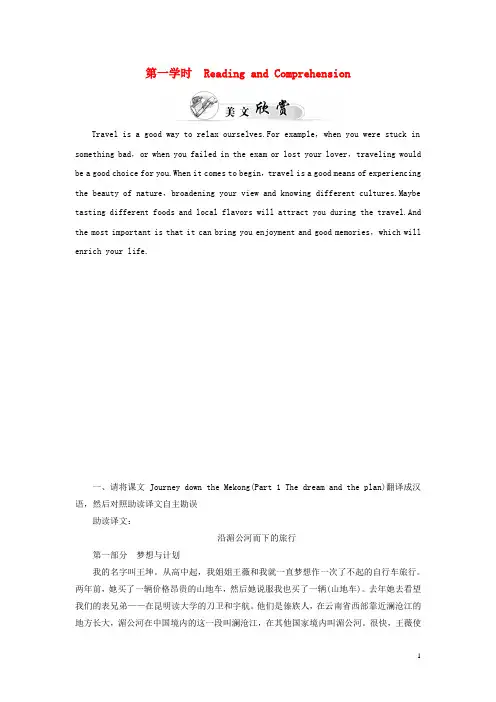
第一学时Reading and ComprehensionTravel is a good way to relax ourselves.For example,when you were stuck in something bad,or when you failed in the exam or lost your lover,traveling would be a good choice for you.When it comes to begin,travel is a good means of experiencing the beauty of nature,broadening your view and knowing different cultures.Maybe tasting different foods and local flavors will attract you during the travel.And the most important is that it can bring you enjoyment and good memories,which will enrich your life.一、请将课文Journey down the Mekong(Part 1 The dream and the plan)翻译成汉语,然后对照助读译文自主勘误助读译文:沿湄公河而下的旅行第一部分梦想与计划我的名字叫王坤。
从高中起,我姐姐王薇和我就一直梦想作一次了不起的自行车旅行。
两年前,她买了一辆价格昂贵的山地车,然后她说服我也买了一辆(山地车)。
去年她去看望我们的表兄弟——在昆明读大学的刀卫和宇航。
他们是傣族人,在云南省西部靠近澜沧江的地方长大,湄公河在中国境内的这一段叫澜沧江,在其他国家境内叫湄公河。
很快,王薇使他们也对骑车旅行产生了兴趣。
大学毕业后,我们终于有了作一次骑车旅行的机会。

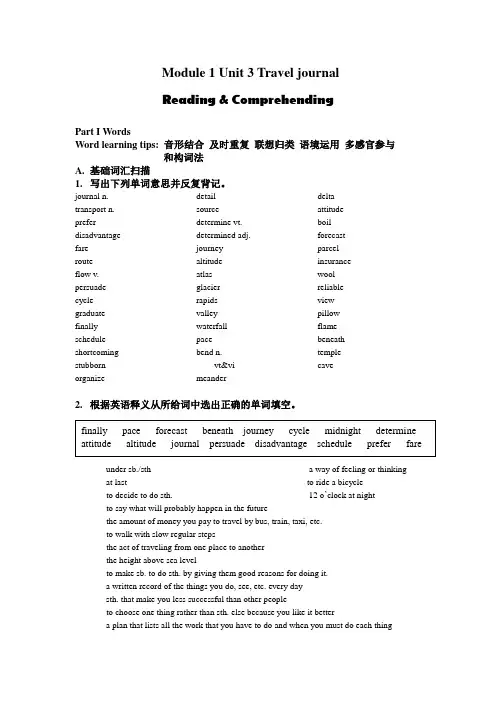
Module 1 Unit 3 Travel journalReading & ComprehendingPart I WordsWord learning tips: 音形结合及时重复联想归类语境运用多感官参与和构词法A.基础词汇扫描1.写出下列单词意思并反复背记。
journal n. _________ transport n. __________ prefer __________ disadvantage _________ fare ___________ route ___________ flow v. ___________ persuade ___________ cycle ___________ graduate ___________ finally ___________ schedule ___________ shortcoming __________ stubborn __________ organize __________ detail ___________source ___________determine vt. _________determined adj. _______journey ___________altitude ___________atlas __________glacier ___________rapids ___________valley __________waterfall __________pace ___________bend n. ___________vt&vi __________meander ___________delta ___________attitude ___________boil ___________forecast ___________parcel ___________insurance ___________wool ___________reliable ___________view ___________pillow __________flame ___________beneath ___________temple ___________cave ___________2.根据英语释义从所给词中选出正确的单词填空。
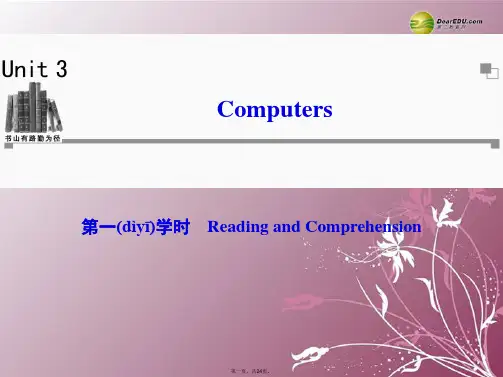
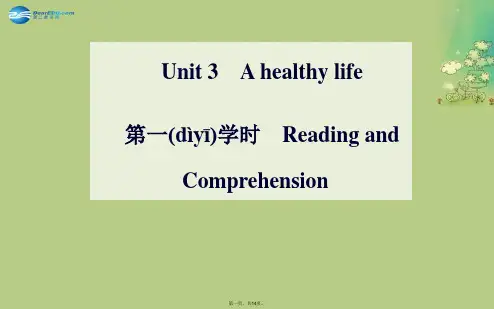
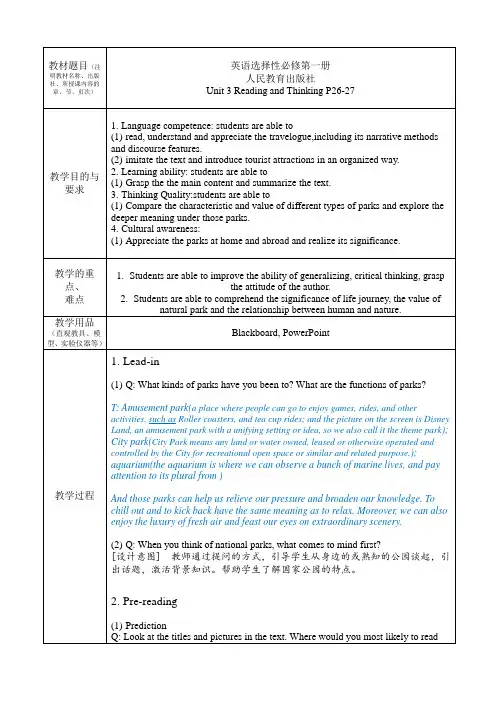
教材题目(注明教材名称、出版社、所授课内容的章、节、页次)英语选择性必修第一册人民教育出版社Unit 3 Reading and Thinking P26-27教学目的与要求nguage competence: students are able to(1)read, understand and appreciate the travelogue,including its narrative methods and discourse features.(2)imitate the text and introduce tourist attractions in an organized way.2.Learning ability: students are able to(1)Grasp the the main content and summarize the text.3.Thinking Quality:students are able to(1)Compare the characteristic and value of different types of parks and explore the deeper meaning under those parks.4.Cultural awareness:(1)Appreciate the parks at home and abroad and realize its significance.教学的重点、难点1.Students are able to improve the ability of generalizing, critical thinking, graspthe attitude of the author.2.Students are able to comprehend the significance of life journey, the value ofnatural park and the relationship between human and nature.教学用品(直观教具、模型、实验仪器等)Blackboard, PowerPoint教学过程1.Lead-in(1)Q: What kinds of parks have you been to? What are the functions of parks?T: Amusement park(a place where people can go to enjoy games, rides, and other activities, such as Roller coasters, and tea cup rides; and the picture on the screen is Disney Land, an amusement park with a unifying setting or idea, so we also call it the theme park); City park(City Park means any land or water owned, leased or otherwise operated and controlled by the City for recreational open space or similar and related purpose.); aquarium(the aquarium is where we can observe a bunch of marine lives, and pay attention to its plural from )And those parks can help us relieve our pressure and broaden our knowledge. To chill out and to kick back have the same meaning as to relax. Moreover, we can also enjoy the luxury of fresh air and feast our eyes on extraordinary scenery.(2)Q: When you think of national parks, what comes to mind first?[设计意图] 教师通过提问的方式,引导学生从身边的或熟知的公园谈起,引出话题,激活背景知识。
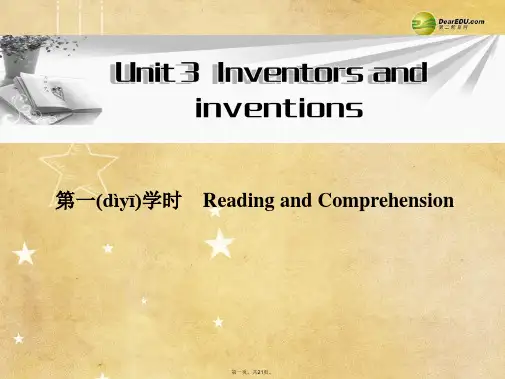

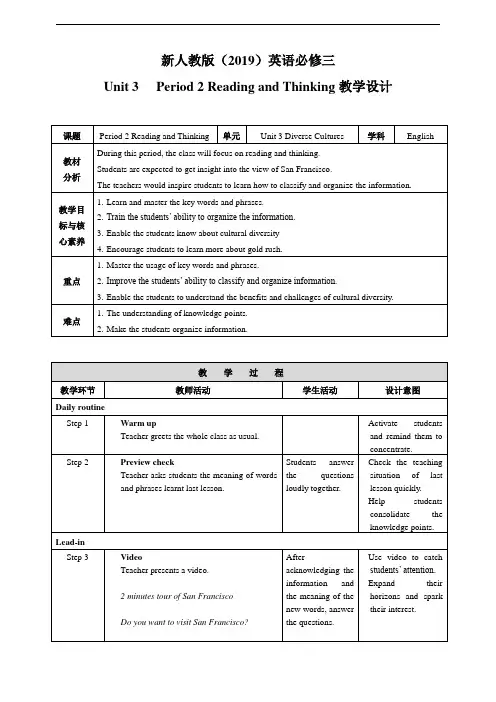
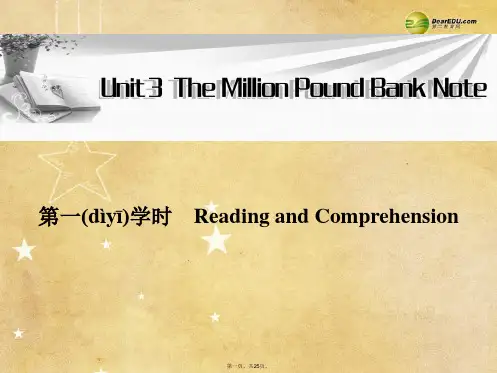
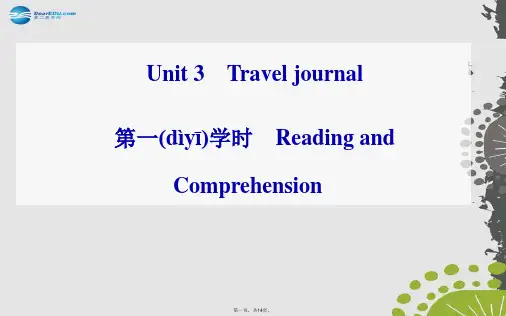
人教版英语精品资料(精修版)Unit1 Warming up,Pre-reading,Reading and Comprehending参考教案Period 1&2Teaching Goals:1. To arouse Ss’ interest in learning about the festivals around the world.2. To improve Ss’ listening ability.3. To train Ss’ speaking ability.Teaching Procedures:Step 1. Leading-inPurpose: To activate Ss and arouse them to express their opinions about a festival. Lead Ss to the content of this unit. Teacher may say, “Do you know what is called the Christmas of China? The Spring Festival. Yes. The oldest and most important festival in China is the Spring Festival. Each country and each nation has its own festivals. Today we are going to learn something about the different festivals.”Step 2. Warming Up1. Ask Ss to turn to P1 and work in groups to complete the form on P1.2. Ask Ss to discuss festivals they have filled in the form and their importance to the society. After that, ask Ss to present their opinions to all classmates.Step 3. Pre-listeningPurpose: To help Ss learn about the context of the Listening text.Ask Ss to talk about the following questions to get them prepared to listen to the reading text.1. How many ancient festivals do you know?2. Are foreign festivals different from Chinese festivals? In what part?Step 4. ListeningPurpose: To get the main information in the listening part.To develop Ss’ listening abilityTo learn some information about the festivals around the world.Ask Ss to listen to the tape, focus on the subjects mentioned in the passage and thenanswer the following question.How many kinds of festivals were mentioned in the text?Suggested Answer: Five.What are they?Suggested Answer:Ancient FestivalsFestivals of the DeadFestivals to Honor PeopleHarvest FestivalsSpring FestivalsStep 5. Pre- readingDivide Ss into groups of four and ask them to discuss the following questions.1. What’s your favorite holiday of the year? Why?2. What festivals or celebrations do you enjoy in your city or town? Do you like spending festivals with your family or with friends? What part of a festival do you like best---the music, the things to see, the visits or the food?Step 6. Fast readingAsk Ss to read the text quickly and answer the following questions.1. What are festivals of the dead usually for?2. What make autumn festivals happy events?3. What do people usually do at spring festivals?4. What is one important reason to have festivals and celebrations?5. Compare the festivals of the dead in Mexico, Japan and China. What things are similar? What things are different?Suggested Answers:1. Festivals of the dead are for honoring or satisfying dead ancestors or others, who some people believe might return to help or harm living people.2. Autumn festivals are happy events because people are thankful that food is ready for winter and the hard farm work is finished.3. At spring festivals, people usually have dances, carnivals and other activities tocelebrate the end of winter and the coming of spring.4. It is important to have festivals and celebrations so we can enjoy life / be proud of our customs / forget our work for a little while.5. The Chinese, Japanese and Mexican festivals of the dead all have customs to honour the dead. The Chinese and Japanese go to clean their ancestors’ graves, and the Mexican offer food, flowers and gifts to the dead. However, there are some differences. The Mexicans eat special food that looks like bones, something the Chinese and Japanese do not do.Step 7. Intensive reading1. Ask Ss to read the text carefully and sum up the main idea of each part.2. Discuss in pairs which festivals you think are the most important and which are the most fun. Then fill in the chart with your ideas.Suggested Answer:Various answers are acceptable.3. Ask Ss the following question and encourage Ss to give some similarities that they think festivals have, and give their reasons. Then invites Ss to tell the similarities and then ask them to present them before the class.What similarities can you find among these festivals?Suggested Answer:They most include food, music or entertainment, like dances, light or fire.They are most together with family and friends.Festivals exist everywhere.Many of them celebrate similar ideas and important cultural events or remember event of people.Human beings need to have things in life to celebrate and have a break from daily struggles and demands.Step 8. HomeworkPurpose: To get a further understanding of the text.1. Ask Ss to continue discussing their opinions about festivals with their partners.2. Ask Ss to read the text once again and try to retell the text.3. Ask Ss to discover useful words and expressions in the text.。
Lesson Plan for“Living Legends”Designer Students to Be Taught SenioroneModule / Unit to be taught Unit 3 Sports and Fitness Type of the Lesson ReadingMaterials Analysis The teaching content “Living legends” is from the unit 3 SPORT AND FITNESS, Reading and Thinking of the book PEP senior high school English compulsory 1.The theme of the Listening and Speaking lesson is “ Invite a friend to a sport event”, which is about describing a sport event and make an invitation. Students will know lots of basic information of some sport event.The theme of Reading and Thinking lesson is “ LIVING LEGENDS”. It’s about the experiences and achievements of Lang Ping and Michael Jordan. Students will learn the excellent qualities of these two successful person.The grammar item of the Discovering Useful Structure lesson is the question and answer of General Question. by learning this section, students will have the ability to apply this grammar item.The Listening and Thinking lesson is “V oice your opinion on sport s manship”, which is about understanding other’s opinion on sport smanship and expressing their own opinions.The theme of the Reading for Writing lesson is “Write a page in a wellness book”. Students will learn the benefit of sports and cultivate the awareness to sports.The contain of the Assessing Your Progress lesson is some exercises of the new words and grammar item in this unit. It can help students to strengthen the knowledge of this unit.The theme of this unit is about sport of the thematic context “Man and Society”.This thematic context includes sports activities, large-scale, sports event, sport and health, sportsmanship.This class mainly involves sport stars and sportsmanship which is closely related to students’ life.ThemeBiographies about two famous sport stars Lang Ping and Michael Jordan posted on a journal.Text typeJournalLanguage knowledgeSince the text is about two famous sports stars, so the linguist items will be as follows: 1.New wordshonour, medal, apart, captain, champion, strength, failuresCultural knowledgeExcellent qualities that students can learn from domestic and foreign athletes, such as never give up and do not be afraid of failure.Language skills1.Distinguish , analyze, and summarize the major opinions and facts in the text.2.Identify the key content points of the text and the corresponding supportingarguments.Learning strategies1.Predict the main content of the text according to the text title and pictures.2.Establish connections between old and new language knowledge.3.Understand the general idea of the text by skimming.Learner Analysis Students are senior students in grade one:1.Are interested in sports.2.Have already known about the topic of sports and some sport stars. Besides, they have the ability of using English to obtain and analyze information and solve questions.3. Do not know the details of Lang Ping and Jordan’s experience;4. Should be able to use the new words to describe a person and use the skills of skimming and scanning in reading.Teaching Objectives By the end of this class, students will be able to:nguage ability objectiveIdentify the meaning of “living legends” and indicate who it refers to in the text.Apply the new words in their language ability2.Thinking capacity objectiveGeneralize the moral quality factors that make Lang Ping and Michael Jordanbecome legends.3.Learning ability objectivePredict the topic of the text by the title of the text.4.Cultural awareness objectiveChoose the good qualities from these two living legends to learn, such as never give up, not afraid of failure.Teaching FocusTeaching Focus Ways OutKey point: Help students to clarifythe passage, understand and tell thestory of living legends.A mind map is designed to help studentsgeneralize the story of the characters.Difficult point: Help students toanalyze the good qualities of livinglegends and learn from them.A discussion was designed to help students learnbetter about the good qualities of the characters,which students need to illustrate based on theirown experiences.Teaching Methodology My teaching philosophy:1.Learners as the center. Teach new words and article content in a way that is interesting and accessible to students, and design a series of student-centered teaching activities.2.Scaffolding principle. From the new words to the main idea to the general content to the key information then to the good qualities of Lang Ping and Michael Jordan. Build a scaffolding for the students. Using the scaffolding principle, from the easy to the difficult. Make students gradually learn the language knowledge and emotional attitudeof this class.Teaching methodology:1.Task Based Language Teaching method. Teach the text content by settinga series of tasks to set an learning goal for students.Teaching Aids PPT slides, blackboard, picturesTeachingflowchartTeaching proceduresStages Steps ActivitiesStage 1: Pre-reading (7mins) 1.Lead-in(5mins)The teacher will introduce some examples of athletes of the 2022Beijing Winter Olympic Games to the students, so that the students arefamiliar with the theme of this lesson, and also teach the new words:honour, medal, champion, strength, failure.2. Prediction (2mins)Ask the students to look at the titles and pictures and guess ‘what the text is about?’ to make a prediction. And learn the text type.Reasons for this stage:The above activities will help students be familiar to the context and theme of the passage. Besides, the new vocabulary they have learned will remove barriers for them to read.Stage 2: While-reading (20mins)3.Skimming(5mins)The teacher will ask students to skim the text to gain the main idea of thetext——It’s about the experiences and achievements of Lang Ping andMichael Jordan.4.Scanning(8mins)The teacher will give students 8 minutes to scan the text and finis themind map of Lang Ping and Micheal Jordan.5. Careful reading (7mins) The teacher asks students to read the text carefully and finish the following exercise.Reasons for this stage: Make students familiar with the deeds and excellent qualities of Lang Ping and Michael Jordan in the article, deepen their understanding of the content of the article, and have a preliminary understanding of the excellent qualities of Lang Ping and Jordan.Stage 3: Post-reading (10mins)6.Groupwork(10mins)Students discuss with their group members about the reason why canLang Ping and Micheal Jordan reach their success.Reasons for this stage: By asked to discuss Lang Ping and Michael Jordan’s reason to their success students will gain a deeper understanding that the good qualities of these two people are the key to their success. Students can learn these qualities more actively.Stage 4: Summary (2mins) The teacher summarizes the good qualities of Lang Ping and Michael Jordan, such as never give up, working like a team, learning from failure.The teacher assigns the following homework for students:Stage 5:Homework(1min)Reasons for this stage: Through the teacher's summary, students can have a deeper understanding of their excellent qualities and learn from them.By asking students to do this homework can exercise their ability to integrate information and have a better understanding of the qualities that are necessary to one’s success.Blackboard design。
Unit3阅读课教案一、Teaching ObjectiveBy the end of the lesson, students will be able to understand and appreciate the achievements and legacies of Langping and Michael Jordan in their respective fields. They will also be able to analyze their impact on society and reflect on their own values and aspirations.二、Teaching Key and Difficult Points:Key Point: Students will be able to understand and appreciate the achievements and legacies of Langping and Michael Jordan in their respective fields.Difficult Point: Students may struggle to connect the achievements of Langping and Michael Jordan to their own lives and values.三、Student Analysis:The students are generally sports enthusiasts who are familiar with Langping and Michael Jordan. They have a basic understanding of their respective achievements, but may not fully appreciate the impact they have had on society or the values they represent.四、Teaching Process:1.Introduction (10 minutes)Begin the lesson by asking students to share their thoughts on Langping and Michael Jordan. What do they know about their achievements and legacies? Why do they think they are considered living legends?2.Presentation (20 minutes)Use visual aids, such as videos or images, to present information about Langping's achievements in table tennis and Michael Jordan's career in basketball. Discuss their impact on the sports world and society as a whole.3.Analysis (15 minutes)Ask students to analyze the legacies of Langping and Michael Jordan. What values do they represent? How have they influenced others? Have they inspired you to pursue your own goals?4.Self-Reflection (10 minutes)Encourage students to reflect on their own values and aspirations. How can they apply the lessons from Langping and Michael Jordan to their own lives? What goals do theyhave for the future?5.Conclusion (5 minutes)Summarize the key points of the lesson and emphasize the importance of appreciating the legacies of living legends like Langping and Michael Jordan. End the lesson with a thought-provoking question or statement that encourages students to continue thinking about the lessons learned throughout the day.。
第一学时Reading and Comprehension
Laptop Computers in School
Computers are popular all over the world,especially laptop computers.People use them on trains and airplanes,in airports and hotels.These laptops connect people to their workplace. In the United States today,laptops also connect students to their classrooms.
As laptops become more powerful,they become more similar to desktop computers.In addition,the portable computers can connect students to not only the Internet,but also libraries and other resources.State highereducation officials are studying how laptops can help students.State officials are testing laptop programmes at other universities,too.At Westlake College,more than 60 percent of the staff use computers.The laptops will allow all teachers to use computers in their lessons.
一、请将课文Who Am I?翻译成汉语,然后对照译文助读自主勘误
译文助读:
我是谁?
经过一段时间我已经被改变了很多。
1642年我在法国诞生时是一台计算机器。
尽管当时我还年轻,但是我能简化一些复杂的数学题。
我发育缓慢,差不多到了两百年之后,查尔斯·巴比奇才把我制成了一台分析机。
在操作员用穿卡孔为我设计程序后,我能够进行逻辑“思考”,并且能够比任何人更快地算出答案。
那时这被当作是一次技术革命,也是我“人工智能”的开始。
在1936年,我真正的父亲艾伦·图灵写了一本书,讲述了怎样使我成为一台“通用机器”来解决任何数学难题。
从那时起,我在体积和脑容量方面迅速成长。
到20世纪40年代,我已经长得像一间屋子那么大,我不知道是否还会长得更大。
但是,这个现实也使得我的设计者很担心。
随着时间的推移,我被弄得越来越小。
自20世纪70年代以来,我一直被用在办公室和家庭里,先是用作个人电脑,后来又做成便携式。
这些变化只有随着我的存储能力的不断提高才能成为可能。
最初是被存储到电子管中,之后是晶体管上,后来是非常小的芯片上。
因此,我已经完全改变了我的形状。
随着我年龄越来越大,我也变得越来越小。
随着时间的推移,我的记忆能力发展得如此之快,就像一头大象一样,从来不会忘记告诉我的任何事情!我的存储容量变得如此巨大,连我自己都不能相信!但是我总是孤孤单单地站在那里,直到20世纪60年代初,人们才给了我一个用网络联成的家庭。
我能够通过万维网和其他人分享我的知识。
从20世纪70年代起,我又被开发出了很多新的用途。
我在通信、金融和商业领域变得非常重要。
我还被放在机器人里面,被用来制作移动手机,并且用来帮助做医疗手术。
我还被放
置在航空火箭里去探测月球和火星。
不管怎样,我的目标是给人类提供高质量的生活。
现在我充满了幸福感,因为我是人类忠实的朋友并时时给他们提供帮助。
二、课文精选段落背诵,请注意意群、连读和升降调
Since the 1970s /many new applications have been found for me. ↘/ I have become very important ⌒in communication,finance / and trade. / I have also ↗been put⌒ in robots and used⌒ to make mobile phones as well as /help with medical operations.
I have⌒ even been put into space rockets /and sent⌒ to explore the Moon and Mars. ↘/Anyhow/, my goal /is to provide humans with a life ⌒of high quality.↘/I am now ↗ / truly filled with happiness/that⌒ I am a devoted friend / and helper of the human race!↘/。